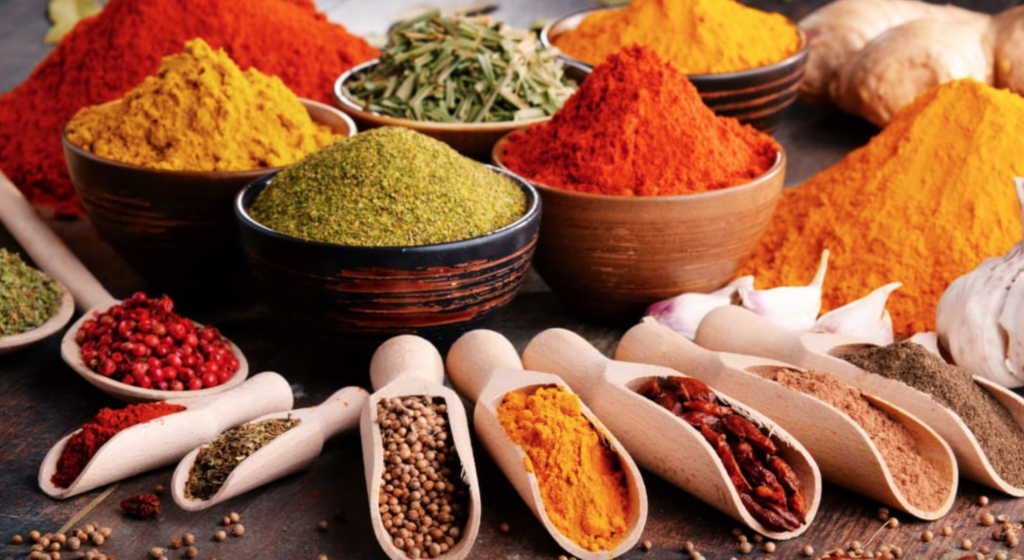
By Shelley Balls, MDA, RD, LD
UW Extension, Nutrition
and Food Safety Educator

So, what is the difference between an herb and a spice? The most common use of the term herb is used to describe plant leaves used for flavoring, and food, such as oregano, basil, rosemary, and parsley. Herbs can be found fresh or dried. So, what is a spice?
Spices are made from the aromatic seeds, bark, flowers, and roots of plants that have been dried. Spices tend to be stronger in flavor since they include the oils in the plant itself.
• Benefits
Using herbs and spices can help flavor your food without the sodium found in salt! The average American consumes 3,400 mg sodium each day. The United States Department of Agriculture recommends we limit our intake of sodium to 2,300 mg a day. If we over-consume sodium on a regular basis, it can increase our risk for high blood pressure, also known as hypertension. Excess sodium intake can also increase our risk for heart disease.
If you’re looking to cut out the sodium but still enjoy a flavorful dish, good choices to use include oregano, tarragon, chives, dill, black pepper, garlic powder, curry powder, cumin, basil, ginger, coriander, and onion.
Using spices and herbs can also make your dishes flavorful and unique! Using just salt and pepper to flavor food every meal can get boring. Try making dishes with curry, ginger, or saffron, to jazz things up without having to eat out somewhere!
• Using Herbs and Spices
If you can’t find fresh herbs, dried herbs can be used in their place. When doing so, remember that dried herbs are stronger than fresh herbs since it’s more concentrated.
A useful guide is: ¼ teaspoon powdered = ¾ to 1 teaspoon dried crumbled = 2 to 3 teaspoons fresh.
When using fresh herbs, chop the leaves very finely, since more flavors will be released when more cut surface area is exposed. To allow the flavors of herbs and spices to blend with cold foods such as dips, dressings, vegetables, and salads add herbs several hours before serving.
• Seasoning Guide
This guide does not mean you cannot try spices on foods that are not listed together here. It just provides some examples of what pairs well together.
HERB FOOD COMBINATIONS – Source: Cent$ible Nutrition Program
• Basil – fresh tomatoes, pasta sauce, peas, zucchini- also used in fresh Pesto!
• Chives – Dips, potatoes, tomatoes
• Cilantro – Mexican, Asian, and Caribbean dishes- also try with salsas and tomatoes
• Dill – Carrots, cottage cheese, fish, green beans, potatoes, tomatoes
• Mint – Carrots, fruit salads, peas, tea, tabouli (salad made with bulgur wheat)
• Oregano – Peppers, tomatoes
• Parsley – Potato salad- curly leaf is the most common parsley but flat-leaf or Italian parsley is more strongly flavored and is often preferred for cooking.
• Rosemary – Chicken, fish, lamb, pork, roasted potatoes, soups, stews, tomatoes, bread
• Sage – Poultry, stuffing
• Tarragon – Chicken, eggs, fish
• Thyme – Eggs, lima beans, potatoes, poultry, summer squash, tomatoes, winter savory Bean dishes, stews
• Create Your Own Spice Blends
You can even make your own herb and spice blends, which will save you money, and you can also control how much sodium is in your mixes. Typically, you will already have a lot of the ingredients that an herb or spice blend will call for. Some examples that you could make include a taco seasoning, ranch seasoning, spice rub, masala, etc.
• Storing Herbs and Spices
The best way to store herbs and spices for longevity of quality is in a cool, dry place, and in air-tight containers. Air-tight containers can include plastic bags, glass jars or stainless-steel containers. Also try to keep containers out of direct sunlight, which fades the color of the herb and reduces the strength.
Whether you’re cooking a warm soup or making a cold salad, don’t be afraid to pull a small amount out in a separate bowl and add whatever herbs and spices you might think would taste good in it. Then, if you like it, you can do the same to the rest of the food, or if you don’t, you won’t be ruining the whole batch! Happy spicing out there everyone!
• Homemade Taco Seasoning
Source: Cent$ible
Nutrition Program
1 tablespoon chili powder
¼ teaspoon garlic powder
¼ teaspoon onion powder
¼ teaspoon crushed red pepper flakes or cayenne pepper
¼ teaspoon dried oregano
½ teaspoon paprika
1 ½ teaspoons ground cumin
1 teaspoon salt (optional)
1 teaspoon black pepper
Combine in small bowl, jar, or plastic bag and mix well. Store in a tightly sealed container. Label and date. Keep in a cool, dry place for up to 6 months. Use 1 tablespoon to flavor 1 pound of ground meat.






